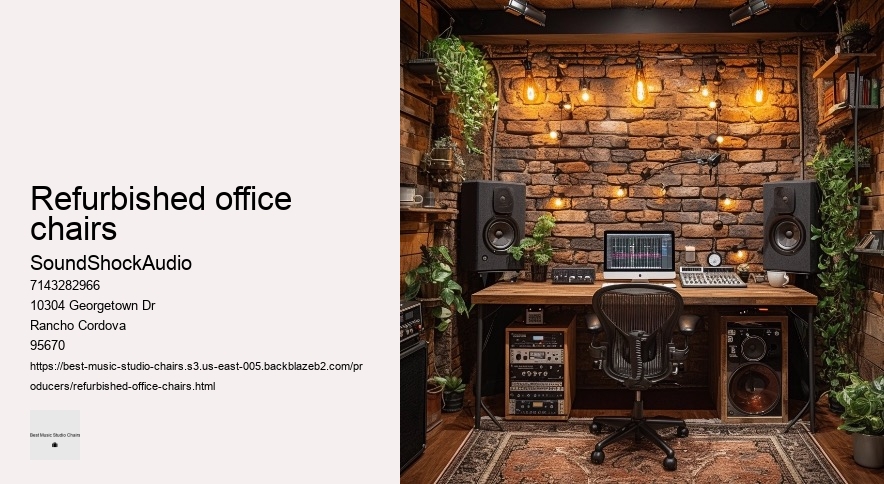

Its sturdy construction guarantees that every component from casters to armrests remains functional through countless recording sessions. Ergonomic chairs encourage a sitting posture that aligns your back, neck, and hips, reducing strain on these areas. Made with recyclable materials and designed for longevity, the Håg Capisco Puls respects both user well-being and ecological sustainability. These less probable options highlight by contrast what makes certain choices superior when selecting an optimal studio chair.
Creating a harmonious and functional small home studio demands meticulous attention to detail, particularly when it comes to selecting the right chair. This increases efficiency as you reach for different pieces of equipment or instruments during your session. Selecting the perfect studio chair is akin to composing a harmonious melody; it requires attention to both comfort and style, ensuring that each element resonates with your personal preferences and workspace needs.
A chair too rigid might impede movement; one too soft could lead to poor posture and subsequent discomfort or even injury over time. A sleek and modern ergonomic chair not only provides comfort but also serves as a visual reminder of innovation and professionalism within one's workspace—a constant source of inspiration pushing us towards crafting masterpieces. But rest assured knowing that investing time researching chairs pays dividends far greater than many initially perceive possible when embarking upon their melodic journey through endless nights bathed in dimly lit studios searching for that perfect beat—that elusive hook—that defining moment where everything clicks into place creating timeless pieces capable of touching souls across generations ad infinitum.
Thus concludes our capricious cataloging of esteemed studio chairs—champions chosen not through frivolous fancy but rigorous rendezvous between artist and instrument; where each note played is nurtured by unseen sentries made tangible only through absence when melody falters upon their departure—a testament to their silent symphony conducted below radar yet resonating beyond audible spectrums. Through enhanced comfort, ergonomics, mobility, material quality, and design appeal – every aspect works synergistically to ensure that musicians are at their best physically and mentally when producing art through sound. Here's an unconventional guide to finding a chair that hits all the right notes.
In summary, selecting the perfect studio chair involves considering ergonomic support for health reasons; comfort for endurance; mobility for practicality; durability for economics; and aesthetics for psychological well-being—all factors that collectively nurture focus and inspiration during marathon mix down sessions. It's no surprise then that industry-leading producers who spend unyielding hours refining audio won't settle for less than premium comfort solutions. Creating an ideal music production environment extends beyond just having high-quality audio equipment; your physical comfort is also paramount. While they don't directly impact comfort or ergonomics, pleasing designs can inspire creativity—a subtle yet significant benefit for those working in creative fields. Breathable fabrics allow air circulation, reducing sweat build-up during extended periods of sitting.
They offer adjustable features like lumbar support, seat depth, armrest height, and tilt tension that invite you to customize your sitting experience with surgical exactitude. Owners can rejoice not only in physical ease but also environmental peace of mind. Its innovative features—temperature regulation, durability, hypoallergenic properties—and potential for enhancement with additional technologies make it a standout material that has truly transformed our expectations for comfortable seating solutions in creative spaces.
Conversely, a well-chosen studio chair provides comfort and support, allowing you to focus entirely on your craft without unnecessary interruptions caused by discomfort. Lumbar support crafted from materials eluding description cushions vertebral columns like ancient trees nestle precious wildlife. home studio desk When days wane long and shadows dance across unfinished canvases or blinking cursors taunt on blank screens, it is then one truly appreciates how profound an impact such an apparently insignificant choice can make. Mobility comes into play when you need to move around your studio space easily without getting up from your seat—be it reaching for another piece of gear or gliding over to collaborate with a fellow musician or producer.
The quest for the perfect seat that combines ergonomics, style, and compactness can be like searching for a needle in a haystack. Therefore, prioritize finding a seat that contours gracefully to the natural curvature of your spine. Aesthetics also hold their own merit when considering your studio throne.
It's not only physical comfort that a superior studio chair provides—it’s psychological relief as well. Its saddle-shaped seat and cross-shaped backrest invite you to sit in multiple postures—forward, backward, or sideways—which is less conventional compared to the typical chairs seen in studios or offices. Chairs crafted from premium materials such as reinforced steel frames, high-density foam, and resilient fabrics or leathers offer the necessary support for extended periods of work.
Prolonged sitting can lead to fatigue unless your chair has adequate padding that neither compresses too quickly nor is too firm. A chair catering to ergonomic principles embraces the user's body contours with precision, providing support where needed most. In conclusion, selecting a music studio chair that exemplifies durability and build quality is essential for any professional working space.


While not as advanced as some higher-end models, its simple design coupled with decent build quality makes it suitable for less intense studio environments. It will result in a composition that may not always make perfect sense or maintain logical coherence, as it deliberately introduces random and potentially unrelated elements into the text. Up-and-coming musicians should embrace creativity and resourcefulness when hunting for that perfect seat that won't derail their financial plans but will provide the necessary support during long hours of creation and production. Choosing one of these chairs means investing in yourself and your craft. Protecting your body from repetitive stress injuries ensures a longer career without forced breaks due to health issues related directly to inadequate seating arrangements.
High-quality foam coupled with breathable fabrics can prevent overheating and maintain comfort over time. Investing in a high-quality model made from robust materials will save money in the long run as it won't require frequent replacements due to wear and tear. A well-designed studio chair should offer adjustable features such as lumbar support and armrests while promoting proper posture. In the realm of creative endeavors, comfort often becomes the unsung hero of productivity.
Tailoring this aspect of a chair helps cradle the natural curve of your spine, offering targeted relief and preventing slouching. Secondly, comfort cannot be overstated. Remember that beating studio fatigue isn't just about having the right equipment—it's about fostering habits that promote well-being both physically and mentally. Whichever camp you fall into, remember that breathability remains essential; materials like mesh allow air circulation which prevents overheating during marathon sessions.
They offer tangible benefits for health and artistic expression even if our discussion includes unexpected detours like "elephants elegantly embroider euphonious echoes," which charmingly illustrates how randomness can sometimes weave poetry into prose but may leave readers bewildered regarding practical advice on choosing seating solutions for music-making endeavors. It aims to support your body so well that you barely notice it's there. The tilt tension control allows users to recline comfortably while maintaining control over their seating angle – an important factor when trying to find an optimal balance between relaxation and concentration during various tasks throughout the day. Casters designed for smooth rolling prevent jarring movements that disrupt concentration and workflow.
The contours are sculpted to perfection, cradling the user in a supportive embrace that defies the conventional rigidity of average office furniture. Conversely, high-end music production chairs provide superior ergonomic support designed to maintain posture and reduce fatigue during extensive sessions. Renowned for its ergonomic design, this chair boasts an innovative suspension system that distributes weight evenly, reducing pressure points.
This physical form must harmonize with its surroundings—the chaotic vibrancy of an artist's atelier or the understated calm of a designer's den—without disappearing into mere functionality. They achieve this through several mechanisms such as self-adjusting lumbar supports, articulated backrests, and responsive seat pans.
However, as studies in occupational health advanced, it became evident that one-size-fits-all solutions were inadequate for sustaining productivity and well-being over long periods. Imagine sitting in an ill-fitting chair.

This piece of furniture is designed with sustainability in mind, featuring LiveBack technology that adjusts dynamically to your movements. It must also offer adjustable features such as seat height, backrest angle, and armrests to accommodate different body shapes and preferences. Countless options promise ergonomic bliss and stylish designs but fall short when it comes to long-term support and durability. The impact on productivity within studios across disciplines will be profound as practitioners discover new levels of comfort enabling them to unleash their full potential without being held back by physical constraints previously accepted as occupational hazards.
Another factor is mobility.
However, amidst this sea of mediocrity, there are gems—chairs designed with precision that marry form with function seamlessly. So what is this game-changing studio chair? Top-tier studio chairs are engineered utilizing robust materials such as reinforced aluminum frames and resilient mesh or leather upholstery. These adjustments allow you to maintain a healthy posture, reducing strain on your back, neck, and shoulders.
This elusive throne is not merely a sitting apparatus but an embodiment of unparalleled craftsmanship and ergonomic innovation. In conclusion, discerning producers must prioritize durability and build quality when selecting their central work tool—their chair—to foster an environment where creativity can flourish unimpeded by concerns over equipment reliability or comfort degradation over time. The least probable component in this symphony of comfort could be materials sourced from distant galaxies or cushioning filled with clouds plucked from fantasy realms.
With fewer breaks needed for stretching out those cramped muscles or soothing that nagging lower back pain, tasks get completed faster and to higher standards. Next is the footprint of the chair. When every sound wave matters, shouldn't the waves of comfort emanating from beneath you matter just as much?
Initially, one must acknowledge that ergonomics transcends simple cushioning. An orchestra pit won’t accommodate giants and pixies alike without adjustable seats. Critics extol its ability to transform hours into fleeting moments.
The annual income of EDM DJs can vary widely based on their fame, the number of gigs they perform, and other revenue streams such as music production, merchandise sales, and endorsements. Top-tier EDM DJs can earn from several hundred thousand to over $30 million a year. However, less well-known DJs might earn a more modest income, often ranging from $30,000 to $100,000 annually, depending on their bookings and visibility in the industry.
The Aeron chair, designed by Herman Miller, is often considered worth the investment due to its high-quality construction, ergonomic design, and durability. It is specifically designed to support a wide range of body types and work styles, promoting better posture and comfort during long periods of sitting. Additionally, its warranty and the brand's reputation for customer service add value to the purchase. However, whether it is worth it ultimately depends on an individual's budget, personal preferences, and how much time they spend sitting.
To choose an office chair for long hours, prioritize features that support ergonomics and comfort, such as adjustable lumbar support, seat height, armrests, and a reclining backrest. Look for chairs with breathable, durable materials to ensure comfort over extended use. It's also beneficial to select a chair with a good warranty, indicating the manufacturer's confidence in its durability and long-term use. Reading reviews from other long-hour users can also provide valuable insights into a chair's real-world performance.